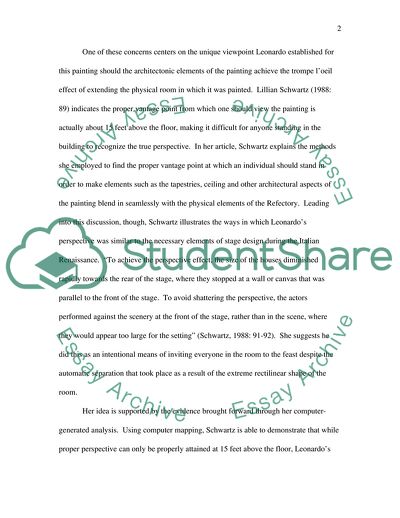Cite this document
(The Story of Leonardo Da Vinci and the Last Supper Essay Example | Topics and Well Written Essays - 1250 words, n.d.)
The Story of Leonardo Da Vinci and the Last Supper Essay Example | Topics and Well Written Essays - 1250 words. https://studentshare.org/culture/1705327-in-this-paper-assignment-i-would-like-you-to-locate-and-address-a-problem-in-one-piece-of-art-of-literature-in-renaissance-florence-this-is-an-exercise-in-re
The Story of Leonardo Da Vinci and the Last Supper Essay Example | Topics and Well Written Essays - 1250 words. https://studentshare.org/culture/1705327-in-this-paper-assignment-i-would-like-you-to-locate-and-address-a-problem-in-one-piece-of-art-of-literature-in-renaissance-florence-this-is-an-exercise-in-re
(The Story of Leonardo Da Vinci and the Last Supper Essay Example | Topics and Well Written Essays - 1250 Words)
The Story of Leonardo Da Vinci and the Last Supper Essay Example | Topics and Well Written Essays - 1250 Words. https://studentshare.org/culture/1705327-in-this-paper-assignment-i-would-like-you-to-locate-and-address-a-problem-in-one-piece-of-art-of-literature-in-renaissance-florence-this-is-an-exercise-in-re.
The Story of Leonardo Da Vinci and the Last Supper Essay Example | Topics and Well Written Essays - 1250 Words. https://studentshare.org/culture/1705327-in-this-paper-assignment-i-would-like-you-to-locate-and-address-a-problem-in-one-piece-of-art-of-literature-in-renaissance-florence-this-is-an-exercise-in-re.
“The Story of Leonardo Da Vinci and the Last Supper Essay Example | Topics and Well Written Essays - 1250 Words”. https://studentshare.org/culture/1705327-in-this-paper-assignment-i-would-like-you-to-locate-and-address-a-problem-in-one-piece-of-art-of-literature-in-renaissance-florence-this-is-an-exercise-in-re.


